How Do You Know When Its Time to Put Your Parakeet Down
This is a post I have been wanting to write for a long fourth dimension, but hesitant to take on. I take done A LOT of piece of work with the professional poultry producers in the past couple years, teaching the best euthanasia techniques and procedures. It is possibly the biggest contribution I will brand in my career to animal welfare. I believe that information technology is office of the responsibility of any animate being owner to reduce the suffering of whatever animal in their care, and euthanasia is an important office of that. I have likewise been asked past many of you in my comment section for advice, and have seen a LOT of questionable things floating around on the cyberspace.
One thing I volition never practise is tell an owner WHEN it is appropriate to euthanize. You need to brand that decision based on your values, ethics and feel. I accept my opinion of whether it is humane to try to set up a broken leg on a craven and try to get her to recover. You have your opinion. Both of our opinions are based on how we compute pain endured vs the value of extending a life. As long every bit we both consider the situation, and make the decision based on the welfare of the animal, we are both right. Of course, we are both wrong as well. Nobody, regardless of experience, ever euthanizes at the perfect time….nosotros do our best and have to live with the decisions.
Euthanasia definitely does not take to be a "do it yourself" procedure. Veterinarians will euthanize birds in well-nigh cases….oft they do not feel comfortable diagnosing or treating, but will still perform this important service. If the price, distance or circumstances preclude you using a vets' services, I would far rather see you lot do the job properly yourself, than botch something every bit important and emotional as this.
Now, some full general data nigh euthanasia. I consider these facts, and take spent a lot of time and study convincing myself of these truths:
- Euthanasia is an effective tool in improving the welfare of an private or grouping of animals
- Euthanasia is more than ofttimes performed too late, rather than besides early. More birds suffer needlessly because their keepers aren't willing to perform the job than suffer a needless early decease.
- Euthanasia is NOT well-nigh making a bird dead. The crucial part is making the bird unconscious quickly. I tin can soak a bird in kerosene, and light it on fire…..it volition ALWAYS end up dead, only this is Not euthanasia. Once a bird cannot feel pain or fear, the method used to kill the body is almost irrelevant, for the bird's welfare.
- The "appetizing" factor in whatever method of euthanasia is non relevant to the bird's welfare. If the bird bleeds, or goes through convulsions, or the act looks violent, the method may yet be very humane. The "yuck" gene is an important component of the effect on the "doer", and this is something to take into consideration, but doesn't necessarily bear on the well-being of the bird.
- Treating an creature with respect will ever issue in better welfare for both the animate being and yourself. If yous are doing the best technique you can, and making decisions based on what is all-time for the bird, you can feel good about what yous do.
With these truths in mind, I am going to draw two methods of euthanasia for backyard poultry keepers to consider. They should exist appropriate for the vast majority of people who raise chickens on a pocket-sized scale. I will depict them in gory detail, and will tell you HOW they piece of work, and why they are humane. There are other methods that are humane….I accept chosen the most attainable methods that I think will be about useful for small flock owners. If you are squeamish, you may want to cease reading now.
Cervical Dislocation
Cervical dislocation is humane, if done properly. The benefits of this method is that it can be done immediately after identifying that a bird should exist euthanized, and needs no tools. Information technology causes unconsciousness in effectually 40 seconds after being applied, and is very repeatable….that is, it works every fourth dimension information technology is done properly. The way cervical dislocation causes unconsciousness is by stretching the neck, dislocating the joint at the base of operations of the skull. This causes the spinal cord (which is very rubberband) to snap, and the resulting recoil causes encephalon damage and unconsciousness through concussion. It causes death by breaking the blood vessels (carotid arteries and jugular veins) so that the encephalon runs out of oxygen.
Cervical dislocation is NOT constructive if the dislocation occurs far down the neck (figure 2), if the neck isn't stretched lengthwise ("breaking the neck" doesn't make the bird unconscious….it volition die, after several minutes), or if bones are crushed in the process. Spinning the bird (referred to sometimes as the "helicopter" method) is unacceptable, and the "broomstick" method is questionable, depending on technique….if you put also much weight on the broomstick, or stand up on it too long, you are causing unnecessary pain and discomfort. The technique that works best, and is recommended by veterinarians and welfare associations is as follows:
- Hold the bird by the legs, tight to your trunk
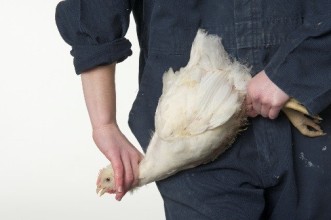
- Grasp the bird by the caput, either between the two fingers of the dominant hand, or by the thumb and commencement finger around the cervix
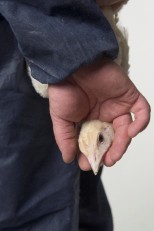
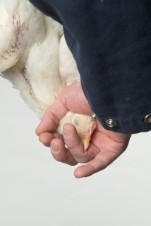
- Tilt the birds caput well dorsum, so information technology points towards the tail of the bird (this position aligns the joints so that it is much easier to dislocate the head from the neck)
- Firmly push the head away from your body until you experience the caput dissever (you will definitely experience the joint allow become)
- Compression simply behind the head to ensure that the caput has separated from the cervix. Y'all will feel a definite gap, and it will feel like at that place are two layers of skin between your fingers.
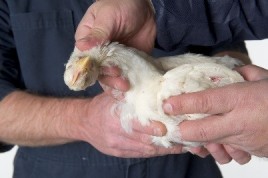
- The bird will convulse and get into spasms….this is normal, and results from the loss of cardinal command over the muscles. The movements practice Not mean the bird is conscious or suffering.
- Ever ensure that the euthanasia has been effective by monitoring the bird until later on convulsions stop and yous can find lack of breathing and that you cannot hear a heartbeat, either by listening to the chest with a stethoscope (if y'all accept i), or past placing your ear against the birds chest.
Decapitation
Decapitation is an effective, humane method of dispatching a suffering fauna. It is NOT instantaneous, only very quick, with unconsciousness usually occurring inside 15-20 seconds. Unconsciousness occurs when the caput is removed, and the Cognitive Spinal Fluid (CSF) escapes from the cutting spinal string. CSF is a fluid that acts to go along the brain and spinal string "floating" inside the skull and spine…..by letting this escape, the brain will come in contact with the skull, causing concussion and unconsciousness. Apparently, decease will follow because of loss of blood flow to the brain. An important gene in this method is that the head MUST be completely removed. Cutting the major vessels and bleeding the bird out is not humane. Yes….the backyard slaughter method used by many small flock owners is NOT adequate. If yous cutting all the claret vessels in the neck, the bird will stay conscious until the oxygen in the encephalon runs out…..3-4 minutes later. Information technology is chosen exsanguination (or "bleeding"), and is identified as an UNACCEPTABLE method of killing a bird by the AVMA (American Veterinary Medical Clan). If you desire to bleed a bird (ie for slaughter), you lot must brand it unconscious first.
Other things to consider when euthanizing via decapitation, are that the blades used must be precipitous, and the head must exist removed in one cut. The bract, or the scissors must exist large enough that i motion completely removes the caput. Scissors are helpful every bit they better human safety. Axes and knives work very well, but you must exist careful! A stump with 2 nails driven in virtually an inch autonomously is a proficient mode to hold the caput safely, and cut cones are very helpful to hold the bird all the same and keep your fingers away from the blade.
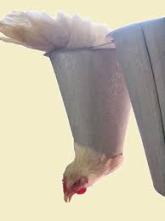
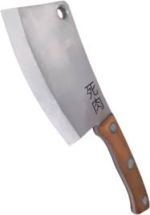
There are other humane methods that can be used, but for various reasons, I don't retrieve are valuable to draw hither. Blunt force trauma is very difficult to do properly, and emotionally disturbing for the person delivering the blow…..the odds of mis-striking amid people who rarely do it are too high for me to recommend it to you. Only, in the hands of an experienced, effective operator, this method is extremely humane, despite the violence of the human action. Carbon Dioxide gas, captive bolt devices, Low Atmospheric stunning, and electrocution are all humane, and yous may hear of them, but demand far too much equipment, are often as well dangerous and need a lot of training to exist washed right. Whatsoever of these methods, done incorrectly, are inhumane.
Remember….euthanasia is not virtually making the bird die….information technology is well-nigh how they become at that place. I've heard of backyard poultry people drowning birds, poisoning them, freezing them and other methods that are NOT humane. I choose to believe that they didn't know of meliorate methods, and hope this article helps.
One concluding point. Consider what your bird is going through every bit you are deciding when to euthanize. Remember that chickens hide pain, even severe pain, very well. Information technology's important to realize that it takes a LOT of discomfort for a bird to stop eating and act sick….hunched up in a corner of a coop. Very often, I feel that more suffering is caused by waiting too long to euthanize than fifty-fifty past people who euthanize incorrectly. It is part of your responsibility as an owner to intendance for your birds, and if her situation is painful and seems hopeless, it is time to first seriously considering euthanasia.
Mike the Chicken Vet
Source: https://mikethechickenvet.wordpress.com/2017/02/16/euthanasia-for-backyard-birds/
0 Response to "How Do You Know When Its Time to Put Your Parakeet Down"
Post a Comment